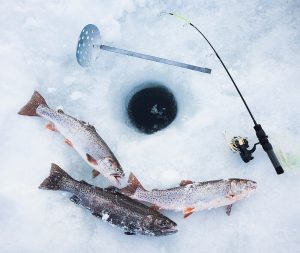Ice fishing offers unique opportunities for anglers during winter, but drilling holes in the ice is a critical step for success and safety. Knowing how to drill properly not only makes fishing easier but also ensures your ice-fishing spot remains effective throughout your trip. This guide outlines the essential steps and tips for creating perfect ice fishing holes.
1. Choose the Right Location
Before drilling, identify an area that’s at least 4 inches thick for walking and a minimum of 12 inches for vehicle use. Thickness can vary, so bring a spud bar or ice chisel to test multiple spots. Ideal locations include areas with underwater structures, drop-offs, or vegetation where fish are likely to congregate.
2. Select Your Ice Auger
There are three primary types of augers: manual (hand), electric, and gas-powered. Manual augers are lightweight and best suited for drilling fewer holes, while electric and gas augers can create multiple holes quickly. Consider ice thickness and how many holes you plan to drill before choosing your auger.
3. Start Drilling
- Position Yourself: Stand with your feet shoulder-width apart for balance.
- Apply Pressure and Begin Drilling: For hand augers, place the blades against the ice and begin turning the handle clockwise with even pressure. Electric and gas augers require minimal force; simply let the blade cut through the ice.
- Maintain Control: As the auger breaks through, reduce downward pressure to prevent sudden drops that could damage the blades or splash water.

4. Clear the Ice Chips
Once you’ve drilled your hole, use a skimmer or slush scoop to remove ice chips and slush from the water. This prevents obstruction of lines and lures and ensures better visibility.
5. Check Hole Diameter
Ensure your hole is the appropriate size for your target species. Common hole diameters range from 6 to 10 inches, with larger holes suitable for bigger fish like northern pike or lake trout.
6. Safety Considerations
- Buddy System: Never ice fish alone; always fish with a partner.
- Spud Bar: Use a spud bar to test ice thickness as you walk.
- Cleats and Ice Picks: Wear cleats for traction and carry ice picks to self-rescue if needed.
]Drilling holes in the ice requires proper preparation and technique for a successful fishing trip. Choose the right auger, select safe ice, and maintain a steady drilling motion to make the process efficient and enjoyable. With practice, drilling holes becomes second nature, allowing you to focus on the thrill of winter fishing.
Image: lookphotos





